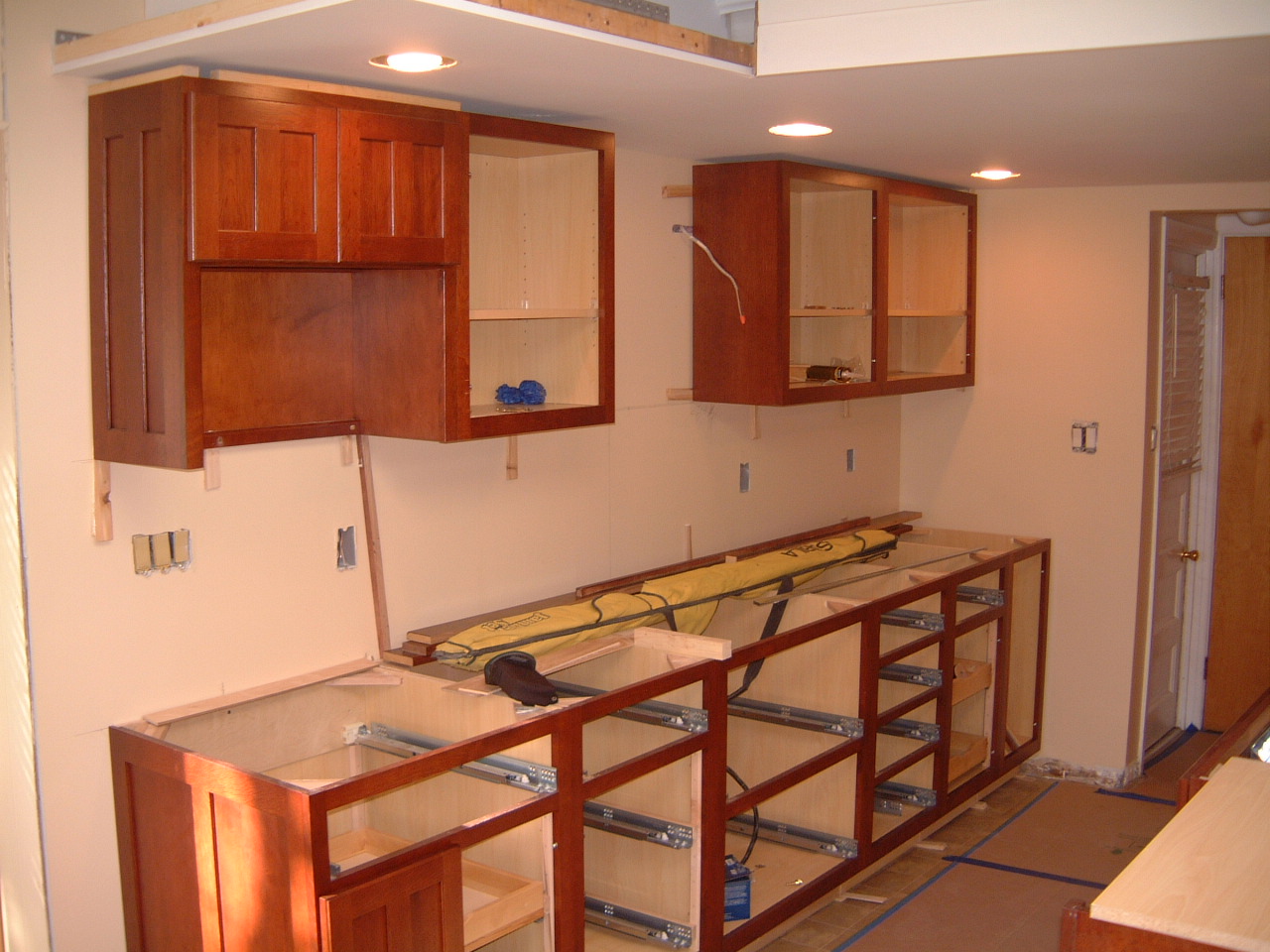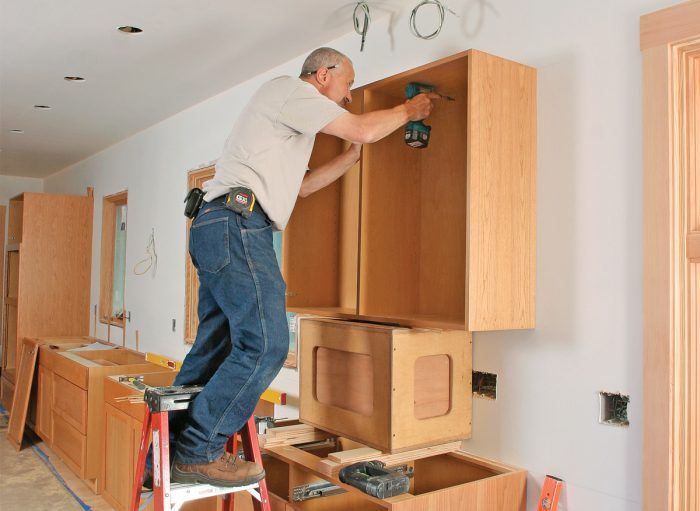Understanding the Concept of Hanging Kitchen Cabinets from the Ceiling: Hanging Kitchen Cabinets From Ceiling

Hanging kitchen cabinets from the ceiling is a popular choice for homeowners looking to maximize space and create a modern, minimalist aesthetic. This method offers unique advantages and considerations compared to traditional wall-mounted cabinets.
Advantages and Disadvantages of Hanging Kitchen Cabinets from the Ceiling
Hanging kitchen cabinets from the ceiling offers several advantages and disadvantages that homeowners should consider before deciding on this approach.
Advantages
- Maximized Space: Hanging cabinets from the ceiling allows for more floor space, creating a less cluttered and more open kitchen. This is especially beneficial in smaller kitchens or kitchens with limited wall space.
- Enhanced Aesthetics: Hanging cabinets from the ceiling can create a contemporary and minimalist look, as the cabinets appear to float and do not obstruct the walls.
- Increased Accessibility: Hanging cabinets higher up can make it easier to access items stored in them, especially for people with limited mobility.
Disadvantages
- Structural Considerations: The ceiling must be strong enough to support the weight of the cabinets and their contents. This may require additional structural reinforcement in older homes.
- Installation Complexity: Hanging cabinets from the ceiling can be more complex and time-consuming to install than wall-mounted cabinets, often requiring professional assistance.
- Limited Storage Space: Hanging cabinets typically have less storage space than wall-mounted cabinets due to the limited depth and the need for a ceiling-mounted support system.
Structural Considerations and Requirements for Supporting Hanging Cabinets
The ceiling must be strong enough to support the weight of the hanging cabinets and their contents. This is especially important for heavier cabinets or cabinets filled with heavy items. The structural requirements for supporting hanging cabinets will vary depending on factors such as:
- Ceiling Material: Different ceiling materials, such as drywall, plaster, or concrete, have different load-bearing capacities.
- Cabinet Weight: The weight of the cabinets themselves, as well as the weight of the items stored inside, will affect the load on the ceiling.
- Cabinet Size and Configuration: The size and configuration of the cabinets, including the number of cabinets and their arrangement, will influence the load on the ceiling.
It is crucial to consult with a structural engineer or a qualified contractor to assess the structural integrity of your ceiling and determine if it can safely support the weight of the hanging cabinets.
Different Types of Ceiling Mounting Systems Used for Kitchen Cabinets
Various ceiling mounting systems are available for hanging kitchen cabinets, each offering different levels of weight capacity and stability. Some common types of ceiling mounting systems include:
- Steel Beams: These are strong and durable, offering high weight capacity. Steel beams are typically used for heavier cabinets or for larger installations where stability is crucial.
- Ceiling Brackets: These are often made of metal or wood and are attached to the ceiling joists. Ceiling brackets are a more affordable option than steel beams and are suitable for lighter cabinets.
- Adjustable Rod Systems: These systems use adjustable rods that are anchored to the ceiling and connect to the cabinets. Adjustable rod systems offer flexibility in cabinet placement and can accommodate different cabinet heights.
- Heavy-Duty Cable Systems: These systems use heavy-duty cables to suspend the cabinets from the ceiling. Cable systems are a good option for large or heavy cabinets, as they distribute the weight evenly.
Comparison of Weight Capacity and Stability of Different Ceiling Mounting Systems
The weight capacity and stability of different ceiling mounting systems can vary significantly.
| Ceiling Mounting System | Weight Capacity | Stability | Cost |
|---|---|---|---|
| Steel Beams | High | Very High | High |
| Ceiling Brackets | Medium | Medium | Medium |
| Adjustable Rod Systems | Medium | Medium | Medium |
| Heavy-Duty Cable Systems | High | High | Medium |
Installation Process and Techniques
Installing hanging kitchen cabinets from the ceiling is a task that requires careful planning and execution. It involves a series of steps, each crucial to ensure a secure and stable installation. This section will guide you through the installation process, highlighting the necessary tools, materials, and techniques.
Tools and Materials
Before embarking on the installation process, it’s essential to gather the necessary tools and materials. This ensures a smooth and efficient installation.
- Stud Finder: This tool helps locate the ceiling joists, providing a secure anchoring point for the cabinets.
- Level: A level is crucial for ensuring the cabinets are installed horizontally and evenly.
- Measuring Tape: Accurately measuring the cabinet dimensions and ceiling spacing is essential for proper placement.
- Pencil: Marking the installation points on the ceiling for drilling pilot holes.
- Drill: Used for drilling pilot holes and securing the cabinets to the ceiling.
- Screwdriver: Required for assembling the cabinets and attaching any hardware.
- Safety Glasses: Protect your eyes from flying debris during drilling.
- Heavy-Duty Ceiling Anchors: These are essential for securing the cabinets to the ceiling, especially if the ceiling joists are not easily accessible.
- Cabinet Mounting Brackets: These brackets are designed to securely attach the cabinets to the ceiling.
- Appropriate Fasteners: Select fasteners that are compatible with the cabinet material and ceiling structure.
Marking and Drilling Pilot Holes
Accurate marking and drilling pilot holes are crucial for a secure and stable installation.
- Locate the Ceiling Joists: Using a stud finder, locate the ceiling joists where you plan to install the cabinets. This ensures the cabinets are anchored to a solid structural element.
- Mark the Installation Points: Use a pencil to mark the precise location of the cabinet mounting points on the ceiling. Ensure these points align with the ceiling joists.
- Drill Pilot Holes: Drill pilot holes at the marked points using a drill bit that is slightly smaller than the diameter of the screws you’ll be using. This helps to prevent the wood from splitting when driving in the screws.
Securing the Cabinets to the Ceiling
Once the pilot holes are drilled, you can proceed to secure the cabinets to the ceiling.
- Attach Mounting Brackets: Attach the cabinet mounting brackets to the ceiling using the appropriate fasteners. Ensure the brackets are securely fastened to the ceiling joists.
- Position the Cabinets: Carefully position the cabinets over the mounting brackets, ensuring they are level and aligned.
- Secure the Cabinets: Use screws or other suitable fasteners to secure the cabinets to the mounting brackets. Tighten the fasteners securely to ensure a stable installation.
Design Considerations and Aesthetics

Hanging kitchen cabinets from the ceiling offers a unique opportunity to enhance the aesthetics and functionality of your kitchen. This approach allows for greater flexibility in design and layout, creating a visually appealing and practical space.
Impact of Cabinet Size and Placement on Kitchen Layout and Functionality, Hanging kitchen cabinets from ceiling
The size and placement of hanging cabinets significantly influence the overall layout and functionality of your kitchen. Carefully consider the following aspects:
- Cabinet Depth: Opt for cabinets with a depth that complements the overall kitchen layout. Deeper cabinets can provide ample storage, but they might encroach on walking space. Conversely, shallower cabinets offer a more open feel, but may limit storage capacity.
- Cabinet Width: The width of the cabinets should be chosen to optimize space utilization. Wide cabinets can create a sense of grandeur, but they might overwhelm a smaller kitchen. Narrower cabinets, on the other hand, offer a more streamlined look and better fit in smaller spaces.
- Cabinet Height: The height of hanging cabinets should be carefully considered. Taller cabinets maximize storage space, but they might create a feeling of claustrophobia in smaller kitchens. Lower cabinets, while offering less storage, can create a more open and airy feel.
- Placement: The placement of hanging cabinets plays a crucial role in creating a balanced and functional kitchen. Consider the flow of traffic, the placement of appliances, and the overall layout when deciding on the positioning of cabinets.
Visual Representation of Various Kitchen Designs Featuring Hanging Cabinets
Visualizing different kitchen designs featuring hanging cabinets can inspire creative ideas and help you determine the best layout for your space.
For instance, imagine a contemporary kitchen with sleek, minimalist cabinets suspended from the ceiling. The cabinets could be designed with integrated lighting, creating a modern and sophisticated ambiance.
Alternatively, consider a rustic kitchen with open shelving hanging from the ceiling. This design allows for easy access to frequently used items and creates a warm and inviting atmosphere.
A traditional kitchen might feature ornate, detailed cabinets with decorative hardware, suspended from the ceiling to add a touch of elegance and sophistication.
Tips for Incorporating Lighting and Other Decorative Elements Around Hanging Cabinets
Lighting and decorative elements can enhance the aesthetics and functionality of hanging kitchen cabinets.
- Under-Cabinet Lighting: Install under-cabinet lighting to illuminate the countertop and create a well-lit workspace. LED strips are a popular choice due to their energy efficiency and sleek appearance.
- Pendant Lights: Pendant lights can be hung above hanging cabinets to provide additional illumination and add a decorative touch. Choose pendant lights that complement the style of your cabinets and overall kitchen design.
- Open Shelving: Incorporate open shelving into the hanging cabinet design to display decorative items, cookbooks, or frequently used kitchen tools. Open shelving can create a sense of openness and add visual interest to the kitchen.
- Decorative Hardware: Choose decorative hardware, such as knobs and pulls, that complement the style of your hanging cabinets and enhance their visual appeal. Consider using hardware in contrasting colors or finishes to create a focal point.
Hanging kitchen cabinets from ceiling – Hanging kitchen cabinets from the ceiling can create a sleek, modern aesthetic, but it also presents an opportunity to enhance the design with unique details. For a touch of industrial chic or a statement-making design, consider using decorative metal sheets for cabinet doors.
These sheets offer a variety of textures and finishes, allowing you to create a truly personalized look that complements the suspended cabinet design. The result is a kitchen that’s both functional and visually captivating.
Hanging kitchen cabinets from the ceiling offers a modern and space-saving solution. While considering the structural integrity for this approach, it’s also crucial to think about the overall design aesthetic. A cohesive look often involves matching elements like cabinet hardware and the kitchen faucet.
Should the kitchen faucet match cabinet hardware? This article delves into the pros and cons of this design choice, offering valuable insights for your kitchen renovation project. Whether you choose to match or contrast, a well-planned kitchen design ensures that hanging cabinets seamlessly integrate with the overall space.

